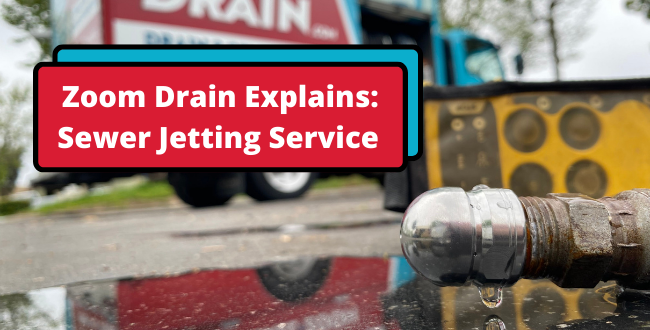When it comes to drains and sewers, it’s important to stay ahead of potential issues. When an emergency problem arises, it could be devastating to your wallet, especially given that your wastewater pipes are typically underneath your property and underground. Whether it’s an emergency clog or simply to eliminate buildup and get your line flowing smoothly, a sewer jetting is the perfect remedy for any drain, in any condition – but what all does that actually entail?
What Is Sewer Jetting And How Does It Work?
It’s like a pressure washer for your drains that uses water to blast away debris and grime.
 Sewer jetting, which is sometimes known as hydro jetting or water jetting, is a non-invasive method of cleaning your drain and sewer lines, which carry wastewater away from your home or business. It’s a safe, efficient and environmentally-friendly way to help rid your drain pipes of any buildup or debris to keep your system healthy, clean and free of any potential blockages. It can be used to help maintain residential, commercial and even municipal drainage systems.
Sewer jetting, which is sometimes known as hydro jetting or water jetting, is a non-invasive method of cleaning your drain and sewer lines, which carry wastewater away from your home or business. It’s a safe, efficient and environmentally-friendly way to help rid your drain pipes of any buildup or debris to keep your system healthy, clean and free of any potential blockages. It can be used to help maintain residential, commercial and even municipal drainage systems.
With the ability to cover as much as 350 feet of even the most inaccessible drain lines, the flexible hose of a water jetter is placed inside the drain. From there, the jetter is turned on with the use of a hand-held remote, pumping pressurized water – from 1,500 to 4,000 PSI – through the line, blasting away debris and buildup forming on the pipe’s wall. In the end, the pipes are left spotless and undamaged. Operating a water jetter is always best left to the experts, who understand wastewater systems and the precise pressure to use based on a drain pipe’s size.
How Often Should You Schedule A Sewer Jetting?
Despite a number of important variables, it should be done at least once a year.
There are a few variables that go into determining exactly how often sewer jetting should be done. The short answer is about once a year, to ensure there’s no buildups forming and no debris that could suddenly create a massive blockage. However, it really depends on the age of the pipes, the general condition they’re in and how often they get used. A house of four people isn’t going to use their drains nearly as much as a popular sit-down restaurant. And, if you plan on moving into a new home, it’s recommended you perform a sewer jetting and a sewer video camera inspection – that way, you’re not purchasing someone’s potentially clogged drains.
What Causes Drain Backups That Require A Sewer Jetting?
Items like food debris and hygiene products can build up over a short amount of time.
When it comes to what goes down your drain, nothing should find its way into your wastewater on purpose besides toilet paper. Anything else can really start to take a toll on your drains – all of the particles and debris from the kitchen sink, garbage disposal, bathtub and shower. It doesn’t take much to form significant buildup and a blockage, even if you remain vigilant! Here are some things that can cause the need for a sewer jetting, to blast gunk from your drains:
- So-called “flushable wipes”
- Congealed cooking oil and grease
- Foods debris such as egg shells, rice and pasta
- Inescapable mineral buildups, like calcium
- Hygiene products such as soaps, sanitary pads and floss
Make sure your wastewater is flowing its best and your lines are completely clean. Give us a call for more information about our sewer jetting service or schedule an appointment online!




.0000000000000.png)
.0000000000000.png)
.0000000000000.png)